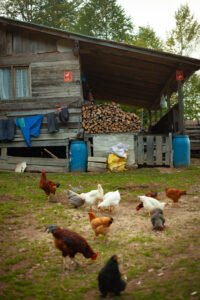
Have you ever wondered if it’s possible to introduce older hens to a flock of younger chickens? Well, the good news is that it can be done! While it may require some patience and careful planning, integrating older and younger chickens can result in a harmonious and diverse flock. In this article, we will explore the benefits of introducing older hens to a younger flock, as well as offer some tips on how to make the integration process as smooth as possible. So, if you’re looking to expand your feathered family or simply curious about mixing different age groups of chickens, read on to discover the joys and challenges of introducing older hens to a flock of younger chickens.
Benefits of Introducing Older Hens to a Flock of Younger Chickens
Boost in Survival Rates for Younger Chickens
Introducing older hens to a flock of younger chickens can significantly boost the survival rates for the younger ones. Older hens have more experience and are better equipped to handle predators and other threats. Their presence provides a sense of security to the younger chickens, reducing stress and increasing their chances of survival.
Increased Socialization and Behavioral Development
Adding older hens to a flock of younger chickens promotes increased socialization and behavioral development among the flock members. Younger chickens learn vital social skills from the older hens, such as effective communication, hierarchy establishment, and appropriate behavior. This interaction helps shape the younger chickens’ behavior and ensures a well-rounded and socially adept flock.
Efficient Resource Utilization
Introducing older hens to a flock of younger chickens can lead to more efficient resource utilization. Older hens are typically experienced foragers and can guide the younger ones to find food efficiently. They also impart their knowledge about feeding habits and help optimize the use of resources within the flock. This efficient resource utilization can lead to healthier and more productive chickens overall.
Transfer of Knowledge and Skills
Older hens possess a wealth of knowledge and skills that they can pass on to the younger generation. From nesting and brooding behaviors to predator avoidance techniques, older hens can teach the younger ones valuable skills that will benefit them throughout their lives. This transfer of knowledge ensures that important survival skills are preserved and passed down from one generation to the next.
Considerations Before Introducing Older Hens to a Flock of Younger Chickens
Health and Disease Control
When introducing older hens to a flock of younger chickens, it is crucial to consider health and disease control. Older hens can carry diseases or parasites that could infect the younger chickens, compromising their well-being. Therefore, it is essential to quarantine and thoroughly observe the health of any new additions before integrating them into the existing flock.
Compatibility and Pecking Order
The compatibility and establishment of a pecking order among chickens are crucial factors to consider when introducing older hens to a flock of younger chickens. The existing hierarchy within the flock may be disrupted by the introduction of new members. It is important to monitor the interactions between the older hens and the younger chickens to ensure a peaceful integration and the establishment of a new pecking order.
Space and Resources
Having sufficient space and resources is essential for successfully introducing older hens to a flock of younger chickens. Overcrowding can lead to increased aggression and competition for food and water. Providing adequate space, nesting areas, and feeding and watering arrangements ensures a harmonious integration and fair distribution of resources among the flock members.
Age and Energy Levels
Considering the age and energy levels of the older hens and younger chickens is crucial for a successful integration. If the older hens are significantly older and have lower energy levels, they may struggle to keep up with the younger chickens’ active behavior. It is important to ensure that both age groups are compatible in terms of energy levels and can coexist without causing unnecessary stress or harm.
Methods for Introducing Older Hens to a Flock of Younger Chickens
Quarantine Period
Before introducing older hens to a flock of younger chickens, it is essential to observe a quarantine period. This allows the new additions to be monitored closely for any signs of illness or disease. During this quarantine period, the older hens can be kept in a separate coop or enclosure to ensure that they do not transmit any potential health issues to the younger chickens.
Introduction in Neutral Territory
To facilitate a smooth integration, it is advisable to introduce the older hens and younger chickens in neutral territory. This reduces the chances of territorial disputes and helps the flock establish a new hierarchy on neutral ground. Neutral territory can be a separate enclosure or an area within the existing flock’s territory that is unfamiliar to all the chickens.
Visual and Auditory Exposure
Gradual exposure to the sight and sound of each other is an effective method for introducing older hens to a flock of younger chickens. Initially, the older hens and younger chickens can be kept in separate enclosures where they can see and hear each other but not physically interact. This allows them to get accustomed to each other’s presence and reduces the chances of aggressive behavior during the actual introduction.
Supervised Integration
Supervised integration involves gradually allowing the older hens and younger chickens to interact under close supervision. This can be done by introducing a few older hens at a time to the younger flock while closely monitoring their behavior. It is important to intervene if any aggressive behavior occurs, and separate any individuals that may be causing distress or harm to the flock.
Slow Introduction
A slow introduction is recommended when integrating older hens into a flock of younger chickens. This involves allowing short periods of supervised interaction between the two groups and gradually increasing their exposure to each other over time. This method allows the chickens to establish a new pecking order and build social bonds without overwhelming them.
Feeding and Watering Arrangements
During the introduction phase, it is important to ensure adequate feeding and watering arrangements for both the older hens and younger chickens. Providing multiple food and water sources can help prevent competition and reduce the chances of aggression. Observation during feeding times can also provide valuable insights into any potential aggression or resource hoarding issues that may need to be addressed.
Monitoring Interactions
Continual monitoring of interactions between the older hens and younger chickens is essential throughout the integration process. Observing their behavior, especially during feeding, roosting, and nesting times, can help identify any signs of aggression, bullying, or resource hoarding. Prompt intervention and necessary adjustments can be made to ensure the overall well-being and harmony of the flock.
Signs of Successful Integration
Establishment of a New Pecking Order
A clear sign of a successful integration is the establishment of a new pecking order. The younger chickens may initially challenge the older hens for dominance, but over time, a new hierarchy will be established. Observation of peaceful interactions and a stable social order among the flock members indicates a successful integration.
Group Foraging and Roosting
Successful integration is often characterized by group foraging and roosting behaviors. Once the older hens and younger chickens have integrated, they should actively engage in foraging activities together and roost together at night. This group behavior indicates that they have accepted each other as part of the flock and are comfortable sharing resources and space.
General Harmony and Reduced Aggression
A successfully integrated flock will exhibit a general sense of harmony and reduced aggression among its members. The older hens and younger chickens should coexist peacefully, without constant aggressive interactions or bullying. A calm and tranquil flock environment indicates a successful integration process.
Collaborative Nesting and Brooding Behaviors
Another sign of successful integration is collaborative nesting and brooding behaviors. The older hens may assist the younger chickens in finding suitable nesting spots and teach them proper brooding techniques. Collaborative nesting and brooding behaviors demonstrate the transfer of knowledge and skills between the generations and reflect a well-integrated and cohesive flock.
Potential Challenges and Solutions
Aggression and Bullying
Aggression and bullying can be a challenge when introducing older hens to a flock of younger chickens. If aggressive behavior occurs, it is important to intervene and separate any individuals that may be causing harm. Providing ample space, multiple feeding and watering areas, and closely monitoring interactions can help address aggression and bullying issues.
Resource Hoarding
Resource hoarding can also be a potential challenge during integration. Some chickens may try to monopolize food or water sources, causing distress and competition within the flock. To address this, it is important to provide multiple feeding and watering areas and ensure a fair distribution of resources. Regular monitoring during feeding times can help identify and address any resource hoarding behavior.
Injury and Veterinary Care
Injuries may occur during the integration process, especially if aggression is not properly managed. It is important to have access to veterinary care to address any injuries or health issues that may arise. Prompt treatment and care can help prevent further complications and ensure the well-being of the flock.
Separation or Rehoming as a Last Resort
In some cases, despite efforts to integrate older hens into a flock of younger chickens, certain individuals may not adapt well or may continuously disrupt the harmony of the flock. As a last resort, separation or rehoming of aggressive or disruptive individuals may be necessary to maintain the overall well-being and balance of the flock.
Building a Balanced Flock
Consideration of Breed Types
When building a balanced flock, it is important to consider the breed types of both older hens and younger chickens. Different breeds have different characteristics and temperaments, which can affect how well they integrate. Choosing breeds that are known to be compatible and have similar energy levels can help ensure a harmonious flock.
Ideal Age Distribution
Maintaining an ideal age distribution is also crucial for a balanced flock. A mix of older hens and younger chickens allows for the transfer of knowledge and skills while maintaining an active and productive flock. It is important to plan breeding and flock management to ensure a continuous supply of younger chickens to replace the aging hens.
Managing Population and Retirement
Proper population management is essential for maintaining a balanced flock. Regularly assessing the flock’s size and considering retirement for older hens that are no longer productive can help prevent overcrowding and ensure sufficient resources for all flock members. Careful planning and management can help create a sustainable and thriving chicken community.
In conclusion, introducing older hens to a flock of younger chickens can provide numerous benefits, including increased survival rates, enhanced socialization and behavioral development, efficient resource utilization, and the transfer of knowledge and skills. However, it is important to consider factors such as health, compatibility, space, and energy levels before introducing older hens. Methods such as quarantine, introduction in neutral territory, visual and auditory exposure, supervised integration, and slow introductions can help facilitate a successful integration. Monitoring interactions and observing signs of successful integration, such as the establishment of a new pecking order and collaborative behaviors, are crucial. Potential challenges such as aggression, resource hoarding, injury, and behavior issues can be addressed through proactive management and intervention. By considering breed types, age distribution, and population management, a balanced and thriving flock can be developed. So, if you are considering introducing older hens to your flock of younger chickens, go ahead and reap the benefits of this harmonious integration.







